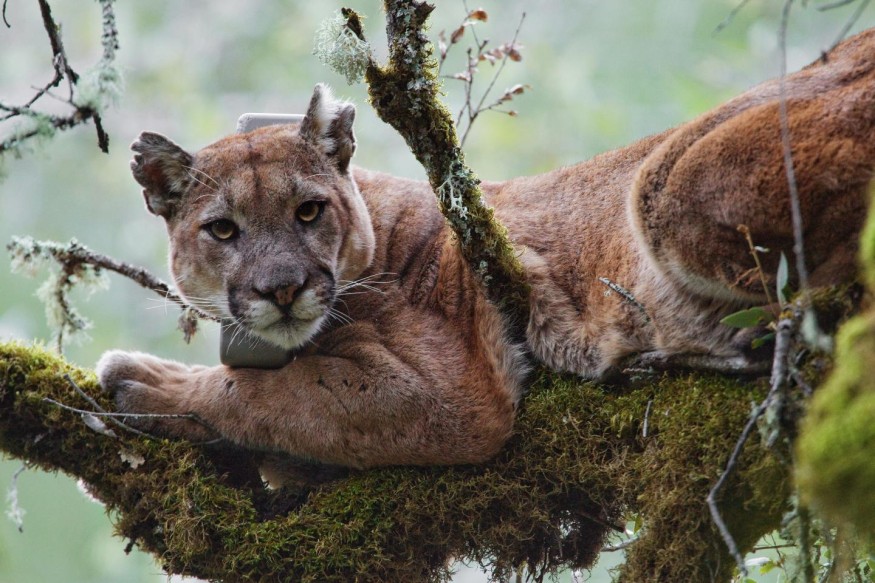

Marine fog brings more than cooler temperatures to coastal areas. Researchers at UC Santa Cruz have discovered elevated levels of mercury in mountain lions, the latest indication that the neurotoxin is being carried in fog, deposited on the land, and making its way up the food chain.
Concentrations of mercury in pumas in the Santa Cruz Mountains were three times higher than lions who live outside the fog zone. Similarly, mercury levels in lichen and deer were significantly higher inside the fog belt than beyond it.
Mercury levels found in pumas are approaching toxic thresholds that could jeopardize reproduction and even survival, according to the researchers, whose findings appear in an article that is available free online at https://www.nature.com/articles.
Led by Peter Weiss-Penzias, an environmental toxicologist who has pioneered the study of pollutants in coastal fog, the study is the first to trace the atmospheric source of super-toxic methylmercury in the terrestrial food web up to a top predator.
"Lichen don't have any roots so the presence of elevated methylmercury in lichen must come from the atmosphere," said Weiss-Penzias. "Mercury becomes increasingly concentrated in organisms higher up the food chain."
Although mercury levels in fog present no health risk to humans, the risk to terrestrial mammals may be significant. With each step up the food chain, from lichen to deer to mountain lions, mercury concentrations can increase by at least 1,000 times, said Weiss-Penzias.
The study included fur and whisker samples from 94 coastal mountain lions and 18 noncoastal lions. Mercury concentrations in the coastal samples averaged about 1,500 parts per billion (ppb), compared to nearly 500 ppb in the noncoastal group. At least one lion studied had mercury levels known to be toxic to species like mink and otters, and two others had "sublethal" levels that reduce fertility and reproductive success.
Elevated concentrations of mercury present an additional potential threat to a top predator that is already coping with habitat loss and other risks posed by humans, said senior author Chris Wilmers, a professor of environmental studies and the director of the Puma Project.
"These mercury levels might compound the impacts of trying to make it in an environment like the Santa Cruz Mountains, where there is already so much human influence, but we don't really know," said Wilmers. "Levels will be higher 100 years from now, when the Earth's mercury budget is higher because of all the coal we're pumping into the atmosphere."
The source of fog-borne mercury
Mercury, a naturally occurring element, is released into the environment through a variety of natural processes and human activities, including mining and coal-fired power plants. "Mercury is a global pollutant," said Weiss-Penzias. "What's emitted in China can affect the United States just as much as what's emitted in the United States."
As atmospheric mercury rains down on oceans, it is converted by anaerobic bacteria in deep waters to methylmercury, the most toxic form of mercury. Upwelling brings some methylmercury to the surface, where it is released back into the atmosphere and carried by fog. At high concentrations, methylmercury can cause neurological damage, including memory loss and reduced motor coordination, and it can decrease the viability of offspring.
"Fog is a stabilizing medium for methylmercury," said Weiss-Penzias. "Fog drifts inland and rains down in microdroplets, collecting on vegetation and dripping to the ground, where the slow process of bioaccumulation begins."
Top predators, an international treaty, and a foggy bike ride
Fog is present in coastal areas that border oceans, environmental "hotspots" that are also home to high concentrations of humans. Weiss-Penzias is eager to investigate mercury levels in coastal Chile, where the top predator is a lizard, while Wilmers is curious about mercury levels in coyotes, bobcats, and birds in coastal areas.
"We need to protect the top predators in the environment," said Weiss-Penzias. "They're keystone species. They perform ecosystem services. When you change one thing, it has cascading effects through the system."
As an example of cascade effects, Wilmers cited the removal of wolves from many states in the eastern United States, which resulted in more coyotes, who preyed on foxes that had historically kept the rodent population in check. The loss of foxes ultimately made way for more rodents, which help transmit Lyme disease, said Wilmers, who added, "Locally, potentially, mountain lions keep deer and small predators in check, which could reduce Lyme disease."
The global effort to protect humans and the environment from mercury includes the Minamata Convention on Mercury, an international treaty that was adopted in 2013. Named after a Japanese city that endured a dire incident of mercury poisoning, the treaty is broad in scope, encompassing the entire life cycle of mercury.
"It's important for the future of that treaty to understand all the different ways that mercury impacts the environment," said Weiss-Penzias.
As an atmospheric chemist, Weiss-Penzias said he first became curious about fog-borne pollutants about a decade ago while riding his bike to work. "I was riding through this absolute fogstorm, with water dripping off my glasses, and I just wondered, 'What's in this stuff?'" he recalled. Hypothesizing that mercury might de-gas out of the ocean and end up in fog, he collected samples and sent them to a lab.
"The lab called me, saying they'd have to re-run the tests, because they didn't believe the numbers," said Weiss-Penzias.
© 2025 NatureWorldNews.com All rights reserved. Do not reproduce without permission.





